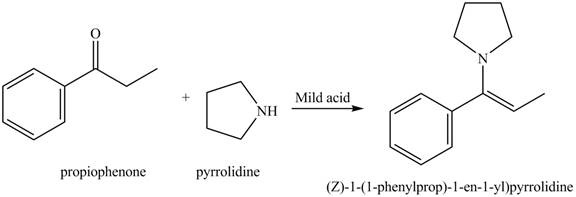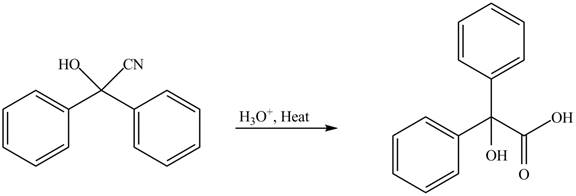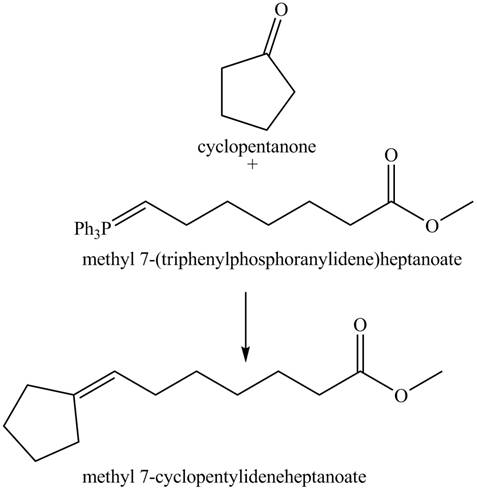
Concept explainers
Draw the products of each reaction.
a.  e.
e. 
b.  f.
f. 
c.  g.
g. 
d.  h.
h. 
(a)
Interpretation: The product of the given reaction is to be drawn.
Concept introduction: A carbonyl compound (aldehyde or ketone) reacts with
Answer to Problem 21.48P
The product of the given reaction isdrawn in Figure 1.
Explanation of Solution
The given reaction involves the treatment of an aldehyde with a
A carbonyl compound (aldehyde or ketone) reacts with
Thus, the product of the given reaction is,

Figure 1
(b)
Interpretation: The product of the given reaction is to be drawn.
Concept introduction: Acetals are the groups in which carbon atom is bonded with two
Answer to Problem 21.48P
The product of the given reaction isdrawn in Figure 2.
Explanation of Solution
The given reaction involves the treatment of a ketone with a diol.
Acetals are the groups in which carbon atom is bonded with two
Thus, the product of the given reaction is,

Figure 2
(c)
Interpretation: The product of the given reaction is to be drawn.
Concept introduction: The hydrolysis of both enamines and imines yield aldehydes or ketones. The mechanisms of both reactions are exactly opposite to their formations, as they are formed from the treatment of aldehyde/ketones with amines.
Answer to Problem 21.48P
The product of the given reaction isdrawn in Figure 3.
Explanation of Solution
The given reaction involves the hydrolysis of an imine.
The hydrolysis of both enamines and imines yield aldehydes orketones along with primary (imine) or secondary amine (enamine). The mechanisms of both reactions are exactly opposite to their formations, as they are formed from the treatment of aldehyde/ketones with amines.
Thus, the product of the given reaction is,

Figure 3
(d)
Interpretation: The product of the given reaction is to be drawn.
Concept introduction: A carbonyl compound (aldehyde or ketone) reacts with
Answer to Problem 21.48P
The product of the given reaction isdrawn in Figure 4.
Explanation of Solution
The given reaction involves the treatment of ketone with
A carbonyl compound (aldehyde or ketone) reacts with
Thus, the product of the given reaction is,

Figure 4
(e)
Interpretation: The product of the given reaction is to be drawn.
Concept introduction: Cyanohydrins are the nucleophilic addition product of carbonyl compounds in which
Answer to Problem 21.48P
The product of the given reaction isdrawn in Figure 5.
Explanation of Solution
The given reaction involves the hydrolysis of cyanohydrin compound.
Cyanohydrins are the nucleophilic addition product of carbonyl compounds in which
Thus, the product of the given reaction is,

Figure 5
(f)
Interpretation: The product of the given reaction is to be drawn.
Concept introduction: Hemiacetals are the groups in which carbon atom is bonded to one
Answer to Problem 21.48P
The product of given reaction isdrawn in Figure 6.
Explanation of Solution
The given reaction involves the treatment of cyclic hemiacetal with ethanol in the presence of acid.
Hemiacetals are the groups in which carbon atom is bonded to one
Thus, the product of the given reaction is,
<
Figure 6
(g)
Interpretation: The product of the given reaction is to be drawn.
Concept introduction: The hydrolysis of both enamines and imines yield aldehydes or ketones along with primary (imine) or secondary amine (enamine). The mechanisms of both reactions are exactly opposite to their formations, as they are formed from the treatment of aldehyde/ketones with amines.
Answer to Problem 21.48P
The product of the given reaction isdrawn in Figure 7.
Explanation of Solution
The given reaction involves the hydrolysis of an enamine.
The hydrolysis of both enamines and imines yield aldehydes or ketones along with primary (imine) or secondary amine (enamine). The mechanisms of both reactions are exactly opposite to their formations, as they are formed from the treatment of aldehyde/ketones with amines.
Thus, the Product of the given reaction is,

Figure 7
(h)
Interpretation: The product of given reaction is to be drawn.
Concept introduction: The Wittig reaction utilizes carbon nucleophile from the Wittig reagent to yield alkenes. When a carbonyl compound is treated with a Wittig reagent, the
Answer to Problem 21.48P
The product of the given reaction isdrawn in Figure 8.
Explanation of Solution
The given reaction involves the hydrolysis of an enamine.
The Wittig reaction utilizes carbon nucleophile from the Wittig reagent to yield alkenes. When a carbonyl compound is treated with a Wittig reagent, the
Thus, the product of the given reaction is,

Figure 8
(a) The product of the given reaction is drawn in Figure 1.
(b) The product of the given reaction is drawn in Figure 2.
(c) The product of the given reaction is drawn in Figure 3.
(d) The product of the given reaction is drawn in Figure 4.
(e) The product of the given reaction is drawn in Figure 5.
(f) The product of the given reaction is drawn in Figure 6.
(g) The product of the given reaction is drawn in Figure 7.
(h) The product of the given reaction is drawn in Figure 8.
Want to see more full solutions like this?
Chapter 21 Solutions
Organic Chemistry-Package(Custom)
Additional Science Textbook Solutions
General, Organic, and Biological Chemistry - 4th edition
Brock Biology of Microorganisms (15th Edition)
Microbiology Fundamentals: A Clinical Approach
Campbell Essential Biology (7th Edition)
- What is the final product when D-galactose reacts with hydroxylamine?arrow_forwardIndicate the formula of the product obtained by reacting methyl 5-chloro-5-oxopentanoate with 1 mole of 4-penten-1-ylmagnesium bromide.arrow_forwardIn the two chair conformations of glucose, the most stable is the one with all the OH groups in the equatorial position. Is this correct?arrow_forward
- please help me with my homeworkarrow_forwardhelparrow_forwardThe temperature on a sample of pure X held at 1.25 atm and -54. °C is increased until the sample boils. The temperature is then held constant and the pressure is decreased by 0.42 atm. On the phase diagram below draw a path that shows this set of changes. pressure (atm) 2 0 0 200 400 temperature (K) Xarrow_forward
- QUESTION: Answer Question 5: 'Calculating standard error of regression' STEP 1 by filling in all the empty green boxes *The values are all provided in the photo attached*arrow_forwardpressure (atm) 3 The pressure on a sample of pure X held at 47. °C and 0.88 atm is increased until the sample condenses. The pressure is then held constant and the temperature is decreased by 82. °C. On the phase diagram below draw a path that shows this set of changes. 0 0 200 temperature (K) 400 аarrow_forwarder your payment details | bar xb Home | bartleby x + aleksogi/x/isl.exe/1o u-lgNskr7j8P3jH-1Qs_pBanHhviTCeeBZbufuBYT0Hz7m7D3ZcW81NC1d8Kzb4srFik1OUFhKMUXzhGpw7k1 O States of Matter Sketching a described thermodynamic change on a phase diagram 0/5 The pressure on a sample of pure X held at 47. °C and 0.88 atm is increased until the sample condenses. The pressure is then held constant and the temperature is decreased by 82. °C. On the phase diagram below draw a path that shows this set of changes. pressure (atm) 1 3- 0- 0 200 Explanation Check temperature (K) 400 X Q Search L G 2025 McGraw Hill LLC. All Rights Reserved Terms of Use Privacy Cearrow_forward
 ChemistryChemistryISBN:9781305957404Author:Steven S. Zumdahl, Susan A. Zumdahl, Donald J. DeCostePublisher:Cengage Learning
ChemistryChemistryISBN:9781305957404Author:Steven S. Zumdahl, Susan A. Zumdahl, Donald J. DeCostePublisher:Cengage Learning ChemistryChemistryISBN:9781259911156Author:Raymond Chang Dr., Jason Overby ProfessorPublisher:McGraw-Hill Education
ChemistryChemistryISBN:9781259911156Author:Raymond Chang Dr., Jason Overby ProfessorPublisher:McGraw-Hill Education Principles of Instrumental AnalysisChemistryISBN:9781305577213Author:Douglas A. Skoog, F. James Holler, Stanley R. CrouchPublisher:Cengage Learning
Principles of Instrumental AnalysisChemistryISBN:9781305577213Author:Douglas A. Skoog, F. James Holler, Stanley R. CrouchPublisher:Cengage Learning Organic ChemistryChemistryISBN:9780078021558Author:Janice Gorzynski Smith Dr.Publisher:McGraw-Hill Education
Organic ChemistryChemistryISBN:9780078021558Author:Janice Gorzynski Smith Dr.Publisher:McGraw-Hill Education Chemistry: Principles and ReactionsChemistryISBN:9781305079373Author:William L. Masterton, Cecile N. HurleyPublisher:Cengage Learning
Chemistry: Principles and ReactionsChemistryISBN:9781305079373Author:William L. Masterton, Cecile N. HurleyPublisher:Cengage Learning Elementary Principles of Chemical Processes, Bind...ChemistryISBN:9781118431221Author:Richard M. Felder, Ronald W. Rousseau, Lisa G. BullardPublisher:WILEY
Elementary Principles of Chemical Processes, Bind...ChemistryISBN:9781118431221Author:Richard M. Felder, Ronald W. Rousseau, Lisa G. BullardPublisher:WILEY





